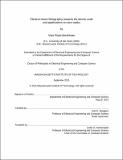| dc.contributor.advisor | Karl K. Berggren. | en_US |
| dc.contributor.author | Manfrinato, Vitor Riseti | en_US |
| dc.contributor.other | Massachusetts Institute of Technology. Department of Electrical Engineering and Computer Science. | en_US |
| dc.date.accessioned | 2016-03-03T20:30:18Z | |
| dc.date.available | 2016-03-03T20:30:18Z | |
| dc.date.copyright | 2015 | en_US |
| dc.date.issued | 2015 | en_US |
| dc.identifier.uri | http://hdl.handle.net/1721.1/101466 | |
| dc.description | Thesis: Ph. D., Massachusetts Institute of Technology, Department of Electrical Engineering and Computer Science, 2015. | en_US |
| dc.description | This electronic version was submitted by the student author. The certified thesis is available in the Institute Archives and Special Collections. | en_US |
| dc.description | Cataloged from student-submitted PDF version of thesis. | en_US |
| dc.description | Includes bibliographical references (pages 146-163). | en_US |
| dc.description.abstract | Electron-beam lithography (EBL) is a high-resolution pattern generation technique widely used in research and development. However, EBL resolution has been limited to 4 nm isolated features and 16 nm periodic structures. Furthermore, the physical mechanisms that limit EBL resolution are not quantitatively clear. The fundamental understanding of the resolution limits of EBL is critically important to push nanotechnology toward the atomic scale. In this thesis we show a comprehensive study of the resolution limiting factors of EBL. We demonstrated that low-energy (sub-5 keV) EBL is able to achieve sub-10 nm half-pitch structures. We investigated the resolution of EBL using an aberration-corrected scanning transmission electron microscope as the exposure tool at 200 keV. We achieved isolated features with critical dimensions of 2 nm and 5 nm half-pitch in hydrogen silsesquioxane resist. We analyzed the resolution limits of this technique by measuring the lithographic point-spread function (PSF). In addition, we measured the delocalized energy transfer in EBL exposure by using chromatic aberration-corrected energy-filtered transmission electron microscopy (EFTEM) at the sub-10 nm scale. We have defined the role of spot-size, electron scattering, secondary electrons, and volume plasmons in the lithographic PSF by performing EFTEM, momentum-resolved electron energy loss spectroscopy (EELS), sub-10 nm EBL, and Monte Carlo simulations. Finally, we show two applications in nano-optics that demand sub-10 nm EBL. First, we performed lithographic placement of nanometer-sized photon sources, i.e., 5-nm-diameter colloidal quantum dots. Second, we fabricated sub-20 nm plasmonic antennas designed to engineer surface and volume plasmons in the ultraviolet region of the electromagnetic spectrum (3 to 30 eV). | en_US |
| dc.description.statementofresponsibility | by Vitor Riseti Manfrinato. | en_US |
| dc.format.extent | 163 pages | en_US |
| dc.language.iso | eng | en_US |
| dc.publisher | Massachusetts Institute of Technology | en_US |
| dc.rights | M.I.T. theses are protected by copyright. They may be viewed from this source for any purpose, but reproduction or distribution in any format is prohibited without written permission. See provided URL for inquiries about permission. | en_US |
| dc.rights.uri | http://dspace.mit.edu/handle/1721.1/7582 | en_US |
| dc.subject | Electrical Engineering and Computer Science. | en_US |
| dc.title | Electron-beam lithography towards the atomic scale and applications to nano-optics | en_US |
| dc.type | Thesis | en_US |
| dc.description.degree | Ph. D. | en_US |
| dc.contributor.department | Massachusetts Institute of Technology. Department of Electrical Engineering and Computer Science | |
| dc.identifier.oclc | 940769191 | en_US |
